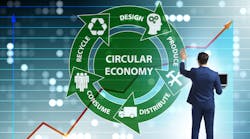Download this article in PDF format.
Focused on designing out waste and pollution, keeping products and materials in use, and regenerating natural systems, the circular economy is coming into focus for more than half of the world’s supply chain leaders right now.
Compared to the linear economy—where resources are taken from the ground to make products that are used and then discarded—the circular economy promotes environmental sustainability in a world where more consumers are demanding that from the companies they work with.
51% Say “Yes”
According to a new Gartner survey, 51% of supply chain professionals expect the focus on their circular economy strategies to increase over the next two years. The firm says there are two main drivers for the increase:
- For one, consumers may not be willing to make big purchases, resulting in product as a service (PaaS) models becoming more attractive.
- And second, a circular economy has the potential to improve raw material security from end-of-life products. Chief supply chain officers (CSCOs) can use circular economy strategies to increase their organization’s raw material security in times of disruption.
“The COVID-19 pandemic has shown that the strengths of globalized supply chains can become a weakness when raw material availability and access plummet during a crisis,” said Sarah Watt, senior director analyst with the Gartner Supply Chain Practice. “For CSCOs, the circular economy is a great opportunity to improve raw material resilience and decouple material consumption from financial growth.”
What’s Holding the Circular Economy Back?
Meeting the requirements of a true, circular economy isn’t always easy. Even the best-intentioned companies run into obstacles when attempting to meet the requirements of the circular economy. For example, organizations can’t always access and reprocess end-of-life products. The other four primary challenges are:
Ownership of end-of-life materials. Most supply chain organizations lose control of products and raw materials at their respective point of sale. This means they must regain access from the consumer at the end of a product’s life. High-tech organizations favor leasing and subscription models because the product will automatically return to them. “Organizations must engage with customers in new ways to gain access to end-of-life materials. Many supply chains rely on new business models or incentives, however 35% rely on customer goodwill,” Watt said.
Quantity of materials. One of the key challenges is to collect and centralize end-of-life products for processing in an economical fashion. Most supply chain organizations collaborate with waste vendors, raw material suppliers and reverse logistics providers to gain access to material.
Value of raw materials. A circular economy still needs to operate within economic boundaries. Products with low residual value are less likely to be processed. While there may be differences in environmental impacts between materials, most of the organization’s decision-making will be based on economics and risk.
“There are a couple of reasons why it can be worthwhile to reclaim end-of-life materials with low residual value,” Watt said. “Reclaiming those assets can act as a hedge against price volatility and increase an organization’s raw material security. Customer sentiment towards certain forms of materials such as single-use plastics has also changed, presenting a reputational risk, which has been a catalyst for action.”
Product complexity. Here’s an area of particular interest for electronics buyers: the less complex a product, the easier and cheaper the reprocessing. One of the easier methods to overcome complexity is by recycling to reclaim primary materials, Gartner says, but recycling leads to loss of value, as the manufactured product is being extinguished in the process.
Only 24% of survey respondents stated that their organization is involved in refurbishment activities. Refurbishment provides more value than recycling as it typically reduces environmental impact and allows the organization to achieve a quick second sale. “Product design is crucial to end-of-life management,” Watt concluded. “Poorly designed products with toxic materials can be incredibly difficult and costly to process and put back into the market.”










